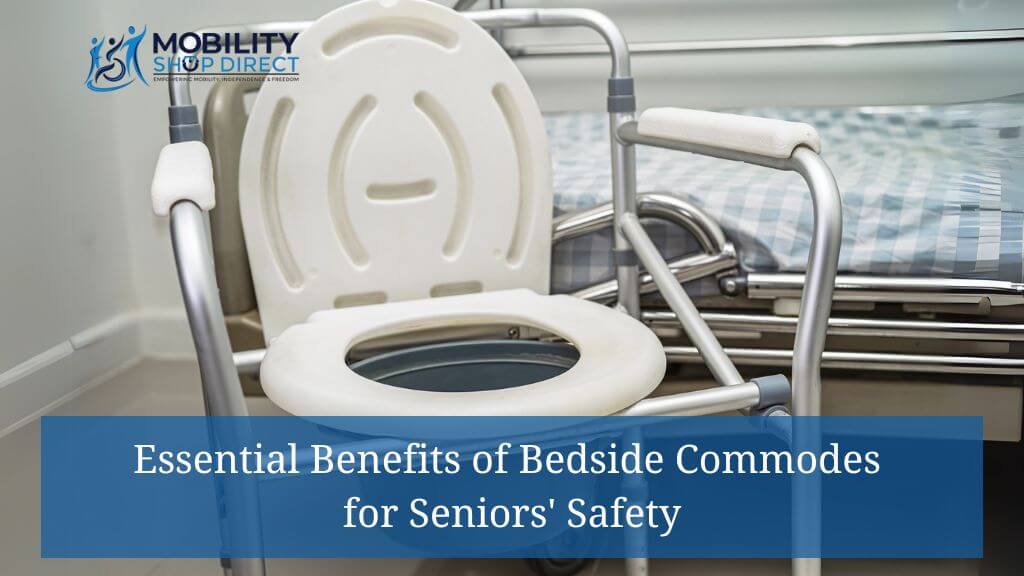For seniors or caregivers navigating the challenges of limited mobility, the bathroom is often the most dangerous part of the home. Slick floors, poor lighting, and the lack of support features all raise the risk of falls. These issues can affect both safety and a senior’s sense of independence. A simple solution like a bedside commode can help reduce those risks while making daily life easier and more comfortable.
Bedside commodes are built with seniors in mind. They include features like height adjustability, stable frames, and multi-use functions. They improve hygiene, reduce caregiver strain, and help seniors stay safe. Whether you're trying to improve bathroom safety or choosing new care tools, understanding how these commodes work is a great place to start.
So how do bedside commodes actually improve safety and simplify care? Let’s break down the top benefits and what to look for when picking the right one.
Table of Contents
- How Bedside Commodes Enhance Safety
- Key Features to Consider in a Bedside Commode
- Simplified Maintenance and Hygiene Tips
- Placement and Accessibility for Maximum Safety
- Choosing the Right Bedside Commode for Individual Needs
- Additional Resources for Bathroom Safety Solutions
Key Takeaways
Want to improve bathroom safety for seniors? Here’s what makes bedside commodes worth considering:
- Safer Mobility: A nearby commode cuts down on risky trips to the bathroom, especially at night.
- Adjustable Heights: A properly adjusted seat reduces strain and improves comfort.
- Stable Design: Sturdy frames and non-slip feet add security during use.
- Multi-Purpose Use: Many commodes can act as toilet frames or even shower seats.
- Easy to Clean: Removable buckets and simple materials keep maintenance low for caregivers.
Let’s go deeper into how bedside commodes support safety and daily routines.
How Bedside Commodes Enhance Safety
Reducing Fall Risks during Nighttime Use
Trips to the bathroom at night can be dangerous, especially when the route is dark or far from the bed. A bedside commode offers a close, stable option that helps prevent dizziness or falls. It gives seniors a safe alternative and gives caregivers more peace of mind.
Improved Bathroom Safety for Elderly Individuals
Bathrooms often have hard floors and tight spaces. These can be risky for seniors with limited strength or balance. A bedside commode avoids these hazards entirely. With stable legs and a secure seat, it creates a safer experience—especially for those who have trouble using standard toilets.
For more details on these safety benefits, check out our guide on how bedside commodes improve senior safety.
Key Features to Consider in a Bedside Commode
Height Adjustability for Senior Comfort
If a commode is too low, it can make sitting or standing difficult. Too high, and it may cause balance problems. Models with adjustable legs let caregivers match the seat height to the user’s comfort level, ensuring safer transfers.
Weight Capacity and Stability Essentials
Always check the weight limit. Most commodes support between 250–400 pounds, but bariatric options handle more. Non-slip feet and solid construction keep the commode steady on smooth floors. Reinforced frames help prevent tipping, especially during transfers.
Exploring 3-in-1 Bedside Commodes
Some commodes can be used three ways: as standalone toilets, over existing toilets, or in the shower. This kind of flexibility helps if you're short on space or caring for someone with changing needs. Just keep in mind that these units are usually bulkier. Learn more in our post on bedside commode types and features.
Portability and Folding Features
For travel or temporary use, lightweight commodes with folding frames are a solid choice. They’re easy to carry, store, and set up in new spots. Compact versions work well in apartments or small homes where space is tight.
Simplified Maintenance and Hygiene Tips
Easy Cleaning Features to Look For
Choose models with removable buckets and splash guards. These contain messes and reduce odor. Look for durable materials like stainless steel or odor-resistant plastic that are easy to wipe down and clean.
Best Practices for Maintaining a Bedside Commode
Empty the waste bucket after each use and clean it regularly with soap and disinfectant. Using disposable liners makes cleanup even faster. Place the commode on a washable mat to catch spills and protect flooring.
Need help creating a routine? Read our step-by-step guide on cleaning and maintaining bedside commodes.
Placement and Accessibility for Maximum Safety
Ideal Placement in the Home for Senior Convenience
Place the commode on the side of the bed that the user naturally exits from. If nighttime use isn’t the focus, keep it near busy areas like the living room or hallway. Avoid uneven flooring or tight corners that make access harder.
Incorporating the Commode into a Safe Daily Routine
Safe use starts with good setup. Teach users how to sit and stand safely using nearby supports. Remove rugs or other tripping hazards. Simple changes like these make the commode easier and safer to use every day.
Choosing the Right Bedside Commode for Individual Needs
Factors to Match the Commode to the User
Consider mobility, strength, and space. Padded seats and armrests help those with limited upper-body control. Lightweight models are great for occasional users, while bariatric commodes are best for those who need extra support. For help choosing, see our full guide on selecting the right bedside commode.
Top Picks: Best Bedside Commodes for Seniors
Brands like Drive Medical and Medline offer durable, easy-to-use options. Some models feature padded seats, splash guards, or tool-free adjustments. Browse our full range of trusted designs in the bedside commode collection.
Additional Resources for Bathroom Safety Solutions
Complementary Tools to Improve Bathroom Safety
Pair your bedside commode with other safety tools like grab bars, anti-slip mats, or raised toilet seats. These additions help round out a safer, easier-to-navigate space and can reduce caregiver strain too.
Conclusion
Bedside commodes are one of the simplest ways to improve comfort, independence, and safety for seniors. From adjustable height and strong frames to low-effort cleaning, they’re designed to meet real-life care needs. Whether used alone or alongside other support tools, they can make daily routines safer and more manageable.
Take the time to choose a model that matches your setup and needs. With the right commode and placement, you're setting up a safer space for daily life—without overcomplicating things.



